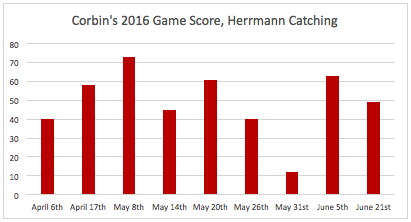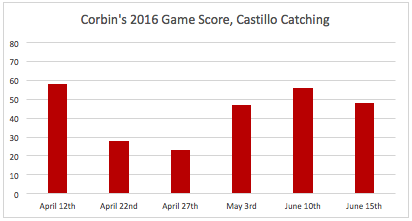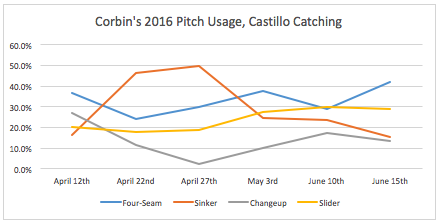Where Did Our Patrick Corbin Go?
There’s no denying that the signing of Zack Greinke and the trade for Shelby Miller took the pitching spotlight off of Patrick Corbin. After all, he was a guy that the team knew they could count on and the moves this winter were meant to support him, rather than have him go it alone as the rotation’s only proven option. He returned in 2015’s second half to not just prove his health and success in recovering from Tommy John surgery in early 2014, but to also prove he was one of the better pitchers in the National League. This was the Patrick Corbin we’ve known and loved. But the Patrick Corbin we’ve seen this year? Well, it’s a pretty unfamiliar version of the young left-hander.
To date, Corbin’s made 15 starts en route to a meaningless 4-6 record and a 4.63 ERA. That’s the worst ERA of his career, and it’s accompanied by his lowest career strikeout rate, his highest career walk rate, and his highest career home run rate. Put those things together and it’s pretty easy to see why the ERA is where it is. Ryan has done a very fantastic job of discussing the Diamondbacks’ efforts to mold their pitching staff into a group of ground ball pitchers, and while Corbin’s ground ball rate is at a career high, it’s seemingly come at some cost. Sometimes pitching adjustments work, sometimes they don’t. If the ground ball focus has been deliberate, I’d say it hasn’t exactly gone according to plan.
Corbin’s biggest change has been, well, his change. It’s a pitch that he came into the season wanting to throw more often and he has, although the results have been devastating. A “feel” pitch, his changeup has been his least valuable offering a by a very wide margin. Used exclusively against right-handed hitters, the pitch has a staggering .778 slugging percentage against by righties who are notching the pitch for hits almost 40% of the time. At some point, the changeup has to just get scrapped, one would think. Then again, Corbin relied on the pitch 15% of the time in his last start, so it would appear that it’s still part of the plan, damned as it may be.
Just as right-handed hitters have responded by bruising changeups, all hitters have responded to Corbin’s game plan by making a small adjustment: they’re swinging less. We all know that Corbin can induce some ugly chases on his slider and even sneak a fastball by hitters from time to time. But Corbin has thrown fewer pitches in the zone this season by 5%, a relatively large mark. Hitters have swung at fewer pitches overall by the same margin, but almost all of that difference has come on pitches out of the zone. They’re just not chasing like they’ve done in the past, and whether that’s because he’s had extra pitches well out of the zone or not, it’s all coming back to haunt Corbin who’s not getting the same swinging strikes he’s used to and has traded them for balls, putting him behind in the count where no pitcher wants to be.
This could be a simple fact of Corbin being more volatile in his ability to locate, which is probable, but it’s also not aided by the fact that Diamondbacks catchers are not exactly good at stealing strikes, something Corbin could really use at the moment. Chris Herrmann and Welington Castillo are among the worst major league catchers at framing, something we’ve long lamented here at Inside the ‘Zona. The struggle continues, apparently.
While this punishes the entire staff equally, Corbin has had a unique blend of the two catchers behind the dish when working against opposing hitters, with Castillo catching six of his starts and Herrmann catching the other nine. One can’t help but wonder if this has had any kind of impact on Corbin as he’s thrown regularly to different targets. We also have to wonder if the two catchers are calling pitches differently. Of his five best starts (by game score), Herrmann has caught four of them. So, what’s the deal? Is there a big discrepancy between what these catchers are doing with Corbin on the mound? First, Corbin’s game score by catcher.
With Herrmann behind the dish, Corbin’s had more highs, but that game on May 31st was simply a clunker. Castillo’s games have been more consistent, but weaker overall. The average game score with Herrmann catching is 49, which is just okay, and Castillo’s average is 43, which is hedging on not good. Getting more granular, here are the rates of pitches used during each catcher’s starts.
You’ll notice right away a change fastball usage, which appears to be the biggest difference. In the two games that Castillo was behind the plate and Corbin struggled, Castillo called more sinkers than four-seamers by a pretty wide margin. That apparently didn’t work. Surprise, surprise, in the game that Corbin stunk up with Herrmann behind the plate (May 31st), Corbin also thew more sinkers than four-seamers. It would stand to reason that the sinker isn’t helping Corbin all that much when it’s used as his primary fastball. Per pitch value, it’s well below the four-seamer. Problems with sinkers, tell me if you’ve heard this before…
Both catchers have ensured that the changeup is the least-used pitch, which is good even if we might argue it shouldn’t be used at all. There are few other discernable patters, though. When we’re looking at the pitches used, and especially when we’re considering how well Corbin’s pitched, it’s a true smattering of usage and results. Just to cap this little comparison off, here are the averages by catcher.
If anything, perhaps we can see that fewer sinkers and fewer changeups are a good idea. Then again, when Corbin dominated in 2013, he threw far more sinkers than four-seamers. I’m not exactly sure what to make of that. We may be able to agree that the changeup experiment isn’t working and the slider is still his best pitch, but the fastball mixture remains a bit of a mystery. Recent marks might suggest the four-seamer is better, but that’s a small sample and the sinker has been good to him in the past.
Maybe it’s an issue that Corbin has seen such a mixture of targets altogether. While the overall usage patterns aren’t wildly different. Perhaps Castillo and Herrmann are using these pitches in different counts. We won’t go there today, but it’s surely something to watch. I doubt Corbin would disparage either of his backstops publicly, but perhaps he has more comfort working with Herrmann. Neither catcher is doing him any favors in terms of framing, but talk to any pitcher and comfort with the catcher certainly counts.
And, in the end, maybe all of this is moot and it’s just an issue of command. Corbin is getting fewer balls over the plate and batters aren’t swinging. There’s no real way to blame that on a particular catcher although we know neither of them is stealing any strikes (in fact, they actually give some away). This just isn’t the Patrick Corbin we’re used to seeing, and though he’s been better of late, he’s still getting killed by righties and we can probably attribute that to the changeup. Perhaps the easiest fix of all is just ditching the pitch, one that sounded like a good idea but hasn’t paid off. With the team riding a four-game winning streak largely on the back on some quality starts (one by Corbin himself), a more consistent Patrick Corbin is vital to the Diamondbacks making any kind of run at the wild card.
5 Responses to Where Did Our Patrick Corbin Go?
Leave a Reply Cancel reply
Recent Posts
@ryanpmorrison
 Congrats to @OutfieldGrass24 on a beautiful life, wedding and wife. He deserves all of it (they both do). And I cou… https://t.co/JzJtQ7TgdJ, Jul 23
Congrats to @OutfieldGrass24 on a beautiful life, wedding and wife. He deserves all of it (they both do). And I cou… https://t.co/JzJtQ7TgdJ, Jul 23 Best part of Peralta’s 108 mph fliner over the fence, IMHO: that he got that much leverage despite scooping it out… https://t.co/ivBrl76adF, Apr 08
Best part of Peralta’s 108 mph fliner over the fence, IMHO: that he got that much leverage despite scooping it out… https://t.co/ivBrl76adF, Apr 08 RT @OutfieldGrass24: If you're bored of watching Patrick Corbin get dudes out, you can check out my latest for @TheAthleticAZ. https://t.co/k1DymgY7zO, Apr 04
RT @OutfieldGrass24: If you're bored of watching Patrick Corbin get dudes out, you can check out my latest for @TheAthleticAZ. https://t.co/k1DymgY7zO, Apr 04 Of course, they may have overtaken the league lead for outs on the bases just now, also...
But in 2017, Arizona ha… https://t.co/38MBrr2D4b, Apr 04
Of course, they may have overtaken the league lead for outs on the bases just now, also...
But in 2017, Arizona ha… https://t.co/38MBrr2D4b, Apr 04 Prior to the games today, there had only been 5 steals of 3rd this season (and no CS) in the National League. The… https://t.co/gVVL84vPQ5, Apr 04
Prior to the games today, there had only been 5 steals of 3rd this season (and no CS) in the National League. The… https://t.co/gVVL84vPQ5, Apr 04
Powered by: Web Designers@outfieldgrass24
 Your weekly reminder that the PAC-12 is a garbage football conference, 5 hours ago
Your weekly reminder that the PAC-12 is a garbage football conference, 5 hours ago This is tremendous! Wonderful job @RichBurk1! https://t.co/V7G0myJ2Ww, Dec 17
This is tremendous! Wonderful job @RichBurk1! https://t.co/V7G0myJ2Ww, Dec 17
Powered by: Web Designers










He needs to throw all sliders! Elbow be damned!
The best pitch in baseball is strike 1. He’s not getting ahead in the count often enough. In 2013 he had 70.3% first pitch strike. last year 61.3%, slightly higher than league avg.
This year 57.4% is well below league avg 60.3%
Among d Backs starters only Rubby and Ray are lower
http://bbref.com/pi/shareit/0eJz5
Among MLB starters he is ranked 106th out of 134
http://bbref.com/pi/shareit/xUzIn
His catchers have a lot to do with this. While somehow Castillo and Hermann have managed to get off the last page of BP’s pitch framing metric, they are still on the 2nd to last page, and -3.0 and 3.9 respectively
http://www.baseballprospectus.com/sortable/index.php?cid=1944824
Adding a little more about first pitch strikes:
Of course you can’t be laying it in there too fat just trying to get ahead. You have to be able to command your pitches on the outer and inner half of the plate and get those calls.
Here are some relevant numbers
MLB
1st pitc in Play .349/.355/.587 .942 OPS
After 1-0 count .269/.380/.452 .832 OPS
After 0-1 count .221/.264/.347 .610 OPS
D Backs
1st pitc in Play .327/.332/.571 .903 OPS
After 1-0 count .284/.398/.476 .874 OPS
After 0-1 count .219/.273/.343 .616 OPS
Corbin
1st pitc in Play .400/.404/.691 1.095 OPS
After 1-0 count .315/.387/.535 .921 OPS
After 0-1 count .196/.259/.288 .547 OPS
So what I see here is really command issues for Corbin. He is not getting ahead as much, and when he tries to get ahead he is coming in FAT and getting crushed. When he does get ahead, then his numbers are significantly better than league average, indicating the stuff is still there.
If we could get a breakdown of 2 seam vs. 4 seam, it would seem intuitive that he is struggling a lot more with command of the 2 seamer. But I would need to see that data to prove that.
Finally……the difference between being ahead and being behind for Corbin when comparing his 2013 season, i.e. 70% vs. 57% mentioned in the previous comment, amounts to about 43 PA of the 332 that have not been put in play on the first pitch.
So 43 PA of .921 OPS instead of .547 OPS
May not seem like a lot, but if you add in sequencing and leverage, I’m sure most of the PA’s that had the highest WPA against started out with either a first pitch fatty getting drilled or after ball 1.
As Ray Miller used to say: “work fast, throw strikes, change speeds”. Our pitchers (Grienke aside) fail miserably on all three legs of that stool. Bradley is trying, though I hope Butcher stays away from him.
[…] The fact that they’re tied in DRA- in the first place is a little concerning for Corbin, who’s had his share of struggles. But he also hasn’t been that bad, either. Two starts into his big league career, Braden […]